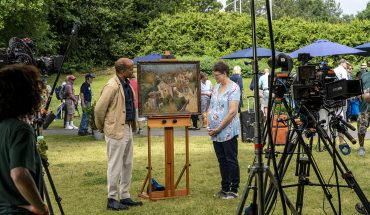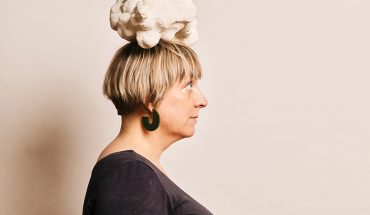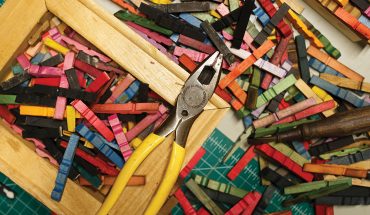North Carolina visual artist Maya Freelon balances strength and fragility in her massive water-stained tissue paper installations.
by Liza Roberts | photography by Chris Charles
Maya Freelon’s tissue paper sculptures are abstract, a confluence of kaleidoscopic color and organic shape. They move with a breeze, the passing of a person, the opening of a door. They make powerful, lasting statements with impermanent, inexpensive materials. Most of all, they are inquisitive. What is art? they ask. What’s it made of? Who gets to make it? Who decides?
The work is about “challenging norms—social norms, economic norms and art norms—by turning tissue paper into a fine work of art,” says Freelon. “It’s about the fragility of life, and transformation, and the ability to see beauty in a lot of different things.”
Often made in collaboration with groups of people, her work celebrates “the communal aspect… the ancestral heritage, the connection to quilt-making in my family and the African-American tradition of making a way out of no way.” Metaphorically and literally, Freelon’s work is a manifestation of its maker: beautiful and forthright, vulnerable but unflinching; lithe, elegant and defiantly individual.
RETURN TO THE TRIANGLE
This month, Freelon’s massive water-stained tissue paper quilts, including pieces made by as many as 100 far-flung community collaborators, will hang from the walls and ceilings of Raleigh’s Contemporary Art Museum (CAM) as part of the Durham artist’s first solo museum exhibition in North Carolina. Also on view will be her tissue ink monoprints, images of streaking color and motion that capture the dripping ink of saturated tissue paper through a process Freelon patented. Some of these include archival family photos, some are on traditional rectangular canvases, some have been crafted in asymmetric shapes and coated in a thick epoxy glaze. Even if the museum can’t open for the public to view these works in person, the show will be installed and shared virtually, says CAM director Gab Smith.
Freelon’s fans around the country and the globe will be glad to hear it. At Miami Art Week last year, she was named one of five young artists to watch. In 2018, she installed massive, wafting tissue paper stalactites at the Smithsonian Arts and Industries Building in Washington, D.C. She’s lived and worked in Madagascar, Eswatini and Italy as part of the U.S. State Department’s Art in Embassies program. She’s collaborated with Google and Cadillac, and her work is in the collections of the Smithsonian National Museum of African American History and Culture, the University of Maryland and the University of North Carolina at Chapel Hill, among others.
Back here in Raleigh, locals helped Freelon use torn tissue and glue sticks to make quilts to hang from the trees outside the North Carolina Museum of Art (NCMA) to celebrate the museum’s expanded African art gallery in September of 2017. NCMA chief curator Linda Dougherty commissioned Freelon’s “quilting bee” installation after seeing a sculpture she’d created for one of the embassies. “Maya had done this beautiful, suspended piece, and I was amazed,” Dougherty says. “I love the ephemeral nature of her materials… they’re meant to be there for the moment, intentionally. It gives her a freedom to experiment. I love that open-endedness.”
INHERITANCE
Freelon’s talent and expressive ability were apparent early on, and she comes by both naturally as the daughter of two renowned artists and the great-granddaughter of another. Her mother, the jazz singer Nnenna Freelon, is a six-time Grammy Award nominee. Her father was revered architect Phil Freelon, the architect of record of the African-American History and Culture Museum on the Mall in Washington, D.C. His own grandfather was Allan Freelon, a noted Impressionist painter whose work was celebrated during the Harlem Renaissance. Her namesake and godmother was the poet Maya Angelou (“Auntie Maya”), a close friend of “Queen Mother” Frances Pierce, Freelon’s beloved grandmother. Angelou once described Freelon’s work, which she bought for her own collection, as “visualizing the truth about the vulnerability and power of the human being.”
Freelon was a precocious teenage talent at Williston Northampton School in Massachusetts, where she transferred to finish high school after two years at the Durham School of the Arts. There, she mostly painted portraits, but “she was always a colorist, very good with color,” says Marcia Reed, her painting instructor at the school, who says that even then, she possessed an impressive “energy and driving force.” By 2006, she was a graduate student at the School of the Museum of Fine Arts in Boston, living with her grandmother Pierce.
It was there that she came upon a stack of multicolored tissue paper in the basement of the house. The paper had most likely been in the same spot for fifty years. Drips from a leaky pipe had mottled the stack over time, moving the color from piece to piece, turning the sheets into gossamer rainbows. Freelon was transfixed, and soon consumed with turning the water-stained tissue paper into art, and using water herself to mark and alter tissue paper, intent on “making something out of nothing.” That discovery, borne out of her connection to her family, became her signature medium.
“Often, artists think they need to work with precious materials,” says Allan Edmunds, founder and director of the Brandywine Workshop and Archives in Philadelphia, where Freelon completed a residency years ago. Her use of tissue paper to make art both sets her apart and connects her to ingenious forebears, says Edmunds. “It’s in the tradition of working with what is available to you and being even more creative because you’ve created a challenge for yourself. I put her in league with El Anatsui.” Coincidentally, it is work by this Ghanaian artist—glittering, undulating woven fabric of found bottle caps—that’s a centerpiece of the NCMA’s permanent collection in the newly-renovated African art gallery that Freelon helped celebrate with her collaborative tissue quilts.
Making something out of nothing is part of the inspiration for the title of Freelon’s exhibit at CAM: Greater Than or Equal To. Freelon also sees the title as an inquiry: “As an artist, as a Black person, as a female, I am constantly raising this question to myself,” she says. How is value—of a person, a life, a work of art—determined, and who determines it? “If we don’t value lives, if we don’t value making this world equal, then we end up having a situation where certain people’s lives mean more than others.” Her use of the symbol ≥ “is to remind folks that it’s a constant question…an opportunity for you to be aware of your judgement and where you’re placing your value.”
She knows where her revered grandmother Pierce would have placed that value. “I think of a quote from my grandmother, which is that we come from a family of sharecroppers who never got their fair share,” she says. Grandmother Pierce’s grandchildren and “every Black person making the world a better place” were “our ancestors’ wildest dreams,” she also said. Freelon considers: “To have survived what it took to get here, and then slavery, and then segregation and racism—we’re living within it, and we’re still existing, and now we have a chance to thrive.”
Personally, Freelon says she’s more than thriving. “I’ve never felt prouder, or better or more grateful that I took the leap, that all of my focus goes to making art and sharing it with the world… I feel like I’m just getting started.”
USING HER VOICE
As Freelon grows in her art, she’s aware of her growing platform, as well. In a video posted on social media on Juneteenth, she says: “My artwork is about using accessible materials to challenge racist paradigms that have been set forth and perpetuated by the white art world.” The video shows her setting fire to her art; an effort to seize attention in support of the Black Lives Matter movement, and to make her message heard. “It’s about creating my own currency and value, and it’s about making space for and inspiring the next generation of Black artists.” In social media and in conversation, Freelon encourages her fellow Black artists to stand up for themselves, to challenge structures that don’t work for them and to know the value of their work.
One day in late June, the day before her birthday and not long before the first anniversary of the death of her father, Freelon is reflective. She is at Vanhook Farm in Hillsborough, a bucolic place where she and her children spend a lot of time. The farm–Black-owned, Freelon points out—has long been in the family of her partner of two years, Jess Vanhook. The location is both a solace and a symbol for Freelon. “I’ve thought about our ancestors and how for them, possessing the land means that you are taking control of your own future,” she says. “You’re asking the earth to produce something for you that has value. I realized that I was doing that as an artist, cultivating something that’s made by my own hands, determining my own value and worth.”
Even as Freelon watches over her nine-year-old son Aion, her three-year old daughter Nova, and Vanhook’s five-year-old nephew Prince, she’s focused on her art and what’s pressing on her mind. That includes supporting and mentoring younger Black artists, telling them the things she wished she’d known earlier on, both practical and philosophical: “Make sure you have an emergency fund. Make sure you apply to at least five grants a year. Be prepared to apply for art residencies that offer free studio space. Reach out to artists you admire, look at their CVs.” In a July Instagram post, she asked followers for the names of Black women artists she can pass on to museums and curators. She wants them to believe in themselves, wants them to “know that their power is their work.”
Freelon says she had to learn all of that “on the fly.” If somebody had told her earlier, she says, “I could have made better choices, more informed choices. We need more community and connection between artists.”
If Freelon sounds older than her 38 years, it could be because she experienced a lot early on. She has been married and wrenchingly divorced, and experienced tragedy with the death of a newborn baby, a three-day-old son named Wonderful. She connects her work directly with that experience. “There are just so many complexities to life, the fragility of it. And back to the artwork: it’s tissue paper. If it gets wet, it will break into a million pieces, but when it is dry, it has power and strength. When you unify those elements, it becomes a force to be reckoned with.”
Art has taught her, despite the challenges she has faced, that everything she needs is within her. “Nobody can determine your future,” she says. As a younger woman, “I think I felt like I needed my parents, or I needed my husband, or I needed things or people to help push me to where I need to be, where in actuality, when everything was stripped away from me, and it was just me left, that’s all I had. That’s when I realized the drive and the energy and the purpose that’s inside.”
And that’s what her art brings her. In her work, Freelon says, “I find peace. I find sanity. I find my purpose. I find—in working with my hands—I find community.
“I find love.”









